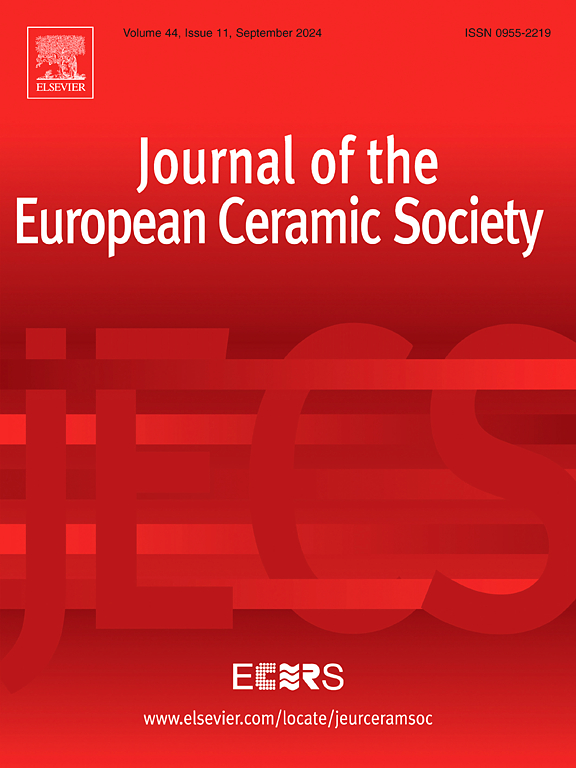Improvement of CMAS corrosion resistance in ytterbium aluminum garnet by multi-phasing of ytterbium oxide
IF 5.8
2区 材料科学
Q1 MATERIALS SCIENCE, CERAMICS
Journal of The European Ceramic Society
Pub Date : 2025-04-22
DOI:10.1016/j.jeurceramsoc.2025.117474
引用次数: 0
Abstract
The corrosion of environmental barrier coatings (EBCs) from calcium-magnesium-aluminosilicate (CMAS) has emerged as a significant challenge. To enhance the corrosion resistance of ytterbium-aluminum-garnet (YbAG) as EBC, this study multi-phased YbAG with ytterbium-oxide (Yb2O3) via a two-step process, including a eutectoid reaction between them. Consequently, the corrosion depth was reduced by approximately one-tenth of its initial value, irrespective of Yb2O3 volume fraction. However, the resultant microstructure exhibited variation with Yb2O3 volume fraction. The YbAG grains transformed into a core/shell structure, increasing the shell thickness with Yb2O3-mutiphasing up to 28vol%-Yb2O3, where the shell is a garnet structure containing the CMAS component as a solid solution. Furthermore, the presence of apatite (Ca2Yb8(SiO4)6O2) and cuspidine [(Yb, Ca, Mg)4(Si, Al)2O9] was observed over 45vol%-Yb2O3. From the standpoint of optimal structural similarity with YbAG, the multi-phasing up to 28vol%-Yb2O3, in which the core/shell structure is the sole reaction phase, was deemed preferable for the EBC.
多相氧化钇提高钇铝石榴石CMAS耐蚀性
钙镁铝硅酸盐(CMAS)环境屏障涂层(ebc)的腐蚀已成为一个重大挑战。为了提高钇铝石榴石(YbAG)作为EBC的耐蚀性,本研究采用两步法将YbAG与氧化钇(Yb2O3)进行多相反应,包括两者之间的共析反应。因此,与Yb2O3体积分数无关,腐蚀深度减少了大约十分之一的初始值。然而,随着Yb2O3体积分数的增加,微观结构发生了变化。YbAG晶粒转变为核/壳结构,随着yb2o3的多相化,壳层厚度增加至28vol%-Yb2O3,其中壳层为石榴石结构,含有CMAS组分作为固溶体。此外,在45vol%-Yb2O3中还观察到磷灰石(Ca2Yb8(SiO4)6O2)和虎碱[(Yb, Ca, Mg)4(Si, Al)2O9]的存在。从与YbAG最优结构相似的角度来看,以核心/壳结构为唯一反应相的多相-Yb2O3为EBC的最佳选择。
本文章由计算机程序翻译,如有差异,请以英文原文为准。
求助全文
约1分钟内获得全文
求助全文
来源期刊

Journal of The European Ceramic Society
工程技术-材料科学:硅酸盐
CiteScore
10.70
自引率
12.30%
发文量
863
审稿时长
35 days
期刊介绍:
The Journal of the European Ceramic Society publishes the results of original research and reviews relating to ceramic materials. Papers of either an experimental or theoretical character will be welcomed on a fully international basis. The emphasis is on novel generic science concerning the relationships between processing, microstructure and properties of polycrystalline ceramics consolidated at high temperature. Papers may relate to any of the conventional categories of ceramic: structural, functional, traditional or composite. The central objective is to sustain a high standard of research quality by means of appropriate reviewing procedures.
 求助内容:
求助内容: 应助结果提醒方式:
应助结果提醒方式:


